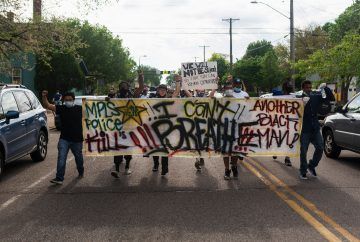Jelani Cobb in The New Yorker:
 Two incidents separated by twelve hours and twelve hundred miles have taken on the appearance of the control and the variable in a grotesque experiment about race in America. On Monday morning, in New York City’s Central Park, a white woman named Amy Cooper called 911 and told the dispatcher that an African-American man was threatening her. The man she was talking about, Christian Cooper, who is no relation, filmed the call on his phone. They were in the Ramble, a part of the park favored by bird-watchers, including Christian Cooper, and he had simply requested that she leash her dog—something that is required in the area. In the video, before making the call, Ms. Cooper warns Mr. Cooper that she is “going to tell them there’s an African-American man threatening my life.” Her needless inclusion of the race of the man she fears serves only to summon the ancient impulse to protect white womanhood from the threats posed by black men. For anyone with a long enough memory or a recent enough viewing of the series “When They See Us,” the locale of this altercation becomes part of the story: we know what happened to five young black and brown men who were falsely accused of attacking a white woman in Central Park.
Two incidents separated by twelve hours and twelve hundred miles have taken on the appearance of the control and the variable in a grotesque experiment about race in America. On Monday morning, in New York City’s Central Park, a white woman named Amy Cooper called 911 and told the dispatcher that an African-American man was threatening her. The man she was talking about, Christian Cooper, who is no relation, filmed the call on his phone. They were in the Ramble, a part of the park favored by bird-watchers, including Christian Cooper, and he had simply requested that she leash her dog—something that is required in the area. In the video, before making the call, Ms. Cooper warns Mr. Cooper that she is “going to tell them there’s an African-American man threatening my life.” Her needless inclusion of the race of the man she fears serves only to summon the ancient impulse to protect white womanhood from the threats posed by black men. For anyone with a long enough memory or a recent enough viewing of the series “When They See Us,” the locale of this altercation becomes part of the story: we know what happened to five young black and brown men who were falsely accused of attacking a white woman in Central Park.
On Monday evening, in Minneapolis, Minnesota, a forty-six-year-old black man named George Floyd died in a way that highlighted the implications that calls such as the one Amy Cooper placed can have; George Floyd is who Christian Cooper might have been. (The police made no arrests and filed no summons in Central Park. Amy Cooper has apologized for her actions; she was also fired from her job.) Police responding to a call from a shopkeeper, about someone trying to pass a potentially counterfeit bill, arrested Floyd. Surveillance video shows a compliant man being led away in handcuffs. But cellphone video later shows a white police officer kneeling on Floyd’s neck for seven minutes, despite protests from onlookers that his life is in jeopardy. In an echo of the police killing of Eric Garner, in 2014, Floyd repeatedly says, “I can’t breathe,” and then, “I’m about to die.” When the officer eventually removes his knee, Floyd’s body is limp and unresponsive. A person nearby can be heard saying, “They just killed him.” Floyd was taken to a hospital, where he was pronounced dead. A police statement saids that Floyd appeared to be in “medical distress,” but made no mention of his being pinned to the ground with the weight of a police officer compressing his airway.
The video of Floyd’s death is horrific but not surprising; terrible but not unusual, depicting a kind of incident that is periodically reënacted in the United States. It’s both necessary and, at this point, pedestrian to observe that policing in this country is mediated by race.
More here.
